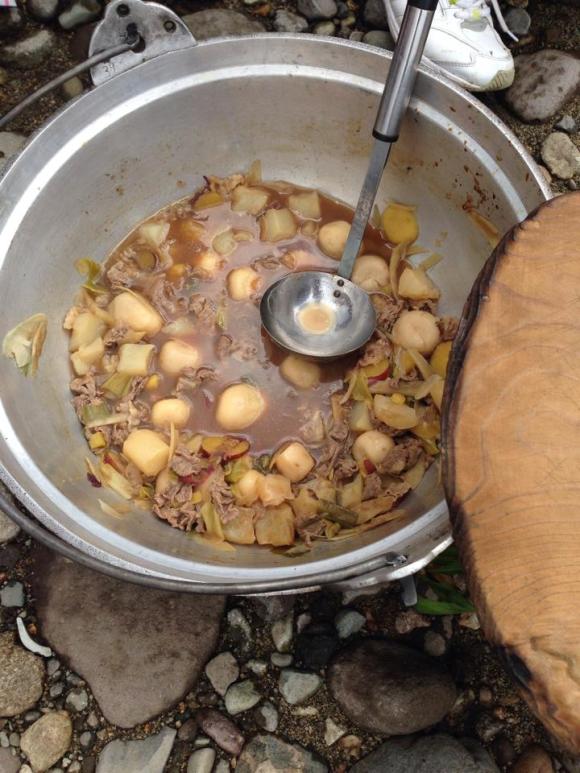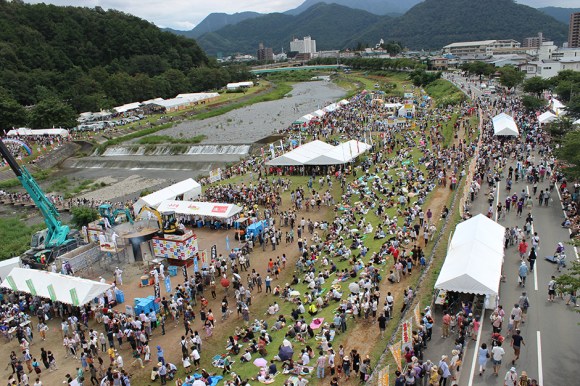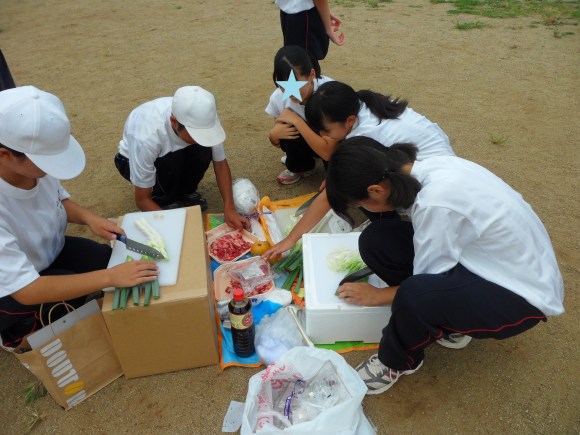
Hop on a train to off-the-beaten-path Yamagata Prefecture any weekend from September through November, and you’re bound to see crowds of people congregating and cooking pots of something delicious by the local river. Yup, imoni-kai season is in full swing!
Imoni (芋煮) is the name given to a taro root stew native to the Tohoku region of northern Japan. Apart from its delicious taste, imoni is also famous for the social aspects of its creation. Families traditionally congregate on a riverbank (the practice of which is known as imoni-kai, literally, “imoni gathering”) and cook the stew from scratch over a fire pit. In that sense, you can think of it a bit like an autumn version of o-hanami, the popular Japanese tradition of viewing cherry blossoms in the spring.
Join us after the jump for a glimpse at a unique cultural tradition of northern Japan which many Japanese people in other parts of the country have never even heard of!
The dish known as imoni is most famous in Yamagata Prefecture, however, it is also consumed in bordering Miyagi Prefecture. While the style of broth may vary slightly from region to region (a soy-sauce base in Yamagata City versus a miso base on the coast), the basic ingredients of imoni remain the same. The main ingredient is satoimo [芋], a kind of tuber which is also called taro root in English, and from which imoni gets its name (ni [煮] refers to a simmered dish). Other common ingredients include thinly sliced beef (or pork), onions, and occasionally kon’nyaku, sometimes rendered as “devil’s tongue” in English. In other words, imoni is the perfect, steaming outdoor treat for a nippy fall day in northern Japan.
▼A typical imoni-kai picnic spread, complimented by onigiri and drinks
▼Imoni served with a side of yakisoba, karaage, and oolong tea
Come the fall, grocery stores in Yamagata often stock special imoni-kai kits which come complete with everything you need for a day’s outing to the river, including a rentable pot, firewood, and chopped, ready-to-go ingredients. Talk about convenience!
▼The banks of the Mamigasaki River in Yamagata City, a typical place for imoni-kai
Although families and friends typically hold their own intimate imoni-kai several times throughout the fall season, there’s a special big event that everyone can look forward to year after year. Yamagata City, the capital of Yamagata Prefecture, hosts an annual imoni festival to celebrate the local dish on the first Sunday of each September. It’s called Nihon Ichi Imoni-kai, or literally, “The Number One Imoni-kai in Japan.” And they’re not joking around–almost the entire city, along with visitors from other parts of Yamagata and outside of the prefecture, gathers on the banks of the local Mamigasaki River to partake of a bowl of imoni, which is prepared in a gigantic iron pot measuring six meters in diameter that must be stirred with construction equipment:
▼The giant iron pot where it rests for most of the year
▼The pot being moved to its location by the river in preparation for “The Number One Imoni-Kai in Japan”
▼What, you thought I was kidding when I said the stew has to be stirred by construction vehicles?
Exactly how much imoni comes out of that pot? Well, to put it simply, A LOT. According to the festival’s official website, three tons of satoimo, 1.2 tons of beef, 3,500 stalks of negi onions, 3,500 packets of kon’nyaku, 700 liters of soy sauce, 90 liters of Nihonshu (Japanese sake), 200 kg of sugar, and six tons of water are dumped into the pot, which is cooked over six tons of firewood to boot! It’s no wonder that so many people are intrigued enough to visit Yamagata for the festival. Even Japanese-Canadian pop rock band Monkey Majik purportedly hops over from their home base of Sendai to have some imoni from time to time!
Here are some more pictures to illustrate the grand scale of the festival:
▼A flier advertising the 26th annual imoni festival, which took place this year on September 14
▼The banner proudly proclaims “Famous product of Yamagata: The Number One Imoni-kai in Japan Fesitval”
▼A bird’s-eye view of the riverbank
▼Despite the massive crowds, the event is well organized with a ticket system and staggered imoni pickup times.
▼The festival also includes pop-up tents selling local products and shows such as this one featuring character mascots of the surrounding regions.
▼Former Yamagata City JET ALTs enjoy their bowls of imoni during the 2012 festival.
▼My own bowl of imoni cooked in the giant pot
Furthermore, in an effort to encourage preservation of the imoni-kai tradition, local Yamagata schools often organize trips to the river to hold imoni-kai. The students do all the work themselves, from starting the fire to chopping ingredients to cleaning up afterwards.
▼Yamagata City junior high school students (US grades 7-9) preparing imoni on a class outing
▼Careful with those knives! I can’t even fathom the administrative hurdles it would take to get permission for American students to do this kind of thing on a field trip…
▼Now that the hard part’s done, all they have to do is sit back, ignore their rumbling stomachs, and wait for it to cook.
▼The finished product. Itadakimasu!
More scenes from class outings:





▼My mouth is watering at the sight of it…

▼Once everyone’s had a bowl of imoni, it’s usual to throw in some udon and let them soak up the remaining broth.

We hope you’ve enjoyed this look at an often overlooked cultural tradition of Japan! I for one would wolf down a bowl of steaming imoni this very second if someone were around to offer me one…
Unless otherwise noted, all images © RocketNews24. “Nihon Ichi Imoni-kai” photos were taken from the Yamagata YEG (1, 2) website. RocketNews24 would like to thank Steven Coull, Lynn Lethin, Darrell Healy, Sam Ghirardello, and Aoife Bradley for their help with this article.



























 We try making imoni, the beloved taro and beef stew of northern Japan【SoraKitchen】
We try making imoni, the beloved taro and beef stew of northern Japan【SoraKitchen】 We eat imoni, a delicious autumn stew, at a unique version of a traditional Japanese festival
We eat imoni, a delicious autumn stew, at a unique version of a traditional Japanese festival Japanese beef bowl chain Sukiya’s 2026 Smile Box lucky bag basically pays for itself
Japanese beef bowl chain Sukiya’s 2026 Smile Box lucky bag basically pays for itself Rakuten randomly offers 58 New Year’s osechi feasts in Japan, but did we get a star or a dud?
Rakuten randomly offers 58 New Year’s osechi feasts in Japan, but did we get a star or a dud? Majority of Japanese mayors say foreign residents are essential but most see good and bad effects
Majority of Japanese mayors say foreign residents are essential but most see good and bad effects Village Vanguard’s most expensive Black Lucky Bag sets an ominous tone for 2026
Village Vanguard’s most expensive Black Lucky Bag sets an ominous tone for 2026 Cardcaptor Sakura Chinese Cafe opens in Tokyo, coming to other cities with special merch【Pics】
Cardcaptor Sakura Chinese Cafe opens in Tokyo, coming to other cities with special merch【Pics】 Shinkansen: “Seats can be quickly used as shields in the event of an attack”
Shinkansen: “Seats can be quickly used as shields in the event of an attack” We suspected this Japanese cable car was an overpriced tourist trip, but we underestimated it
We suspected this Japanese cable car was an overpriced tourist trip, but we underestimated it Japan’s otoshidama tradition of giving kids money at New Year’s gets a social welfare upgrade
Japan’s otoshidama tradition of giving kids money at New Year’s gets a social welfare upgrade Pizza Hut Japan’s hot lucky bags are perfect for a New Year’s pizza party
Pizza Hut Japan’s hot lucky bags are perfect for a New Year’s pizza party Stamina-destroying “Paralysis Noodles” are Tokyo’s newest over-the-top ramen innovation
Stamina-destroying “Paralysis Noodles” are Tokyo’s newest over-the-top ramen innovation Starbucks Japan ready to get Year of the Horse started with adorable drinkware and plushies【Pics】
Starbucks Japan ready to get Year of the Horse started with adorable drinkware and plushies【Pics】 Hayao Miyazaki says Happy New Year to Studio Ghibli fans with new art for Year of the Horse
Hayao Miyazaki says Happy New Year to Studio Ghibli fans with new art for Year of the Horse We found possibly the quietest Japanese-style hotel in Tokyo’s bustling Shinjuku district
We found possibly the quietest Japanese-style hotel in Tokyo’s bustling Shinjuku district Cup Noodle tries an authentic Jiro-style ramen, but something’s not quite right
Cup Noodle tries an authentic Jiro-style ramen, but something’s not quite right The best Starbucks Japan Frappuccinos we want to drink again in 2026
The best Starbucks Japan Frappuccinos we want to drink again in 2026 We revisited Sweets Paradise after a decade to see if Japan’s dessert buffet still delivers
We revisited Sweets Paradise after a decade to see if Japan’s dessert buffet still delivers That time Seiji called JASRAC to ask why he didn’t get paid royalties for his song being on TV
That time Seiji called JASRAC to ask why he didn’t get paid royalties for his song being on TV Japan’s oldest largetooth sawfish in captivity back on display in Mie Prefecture
Japan’s oldest largetooth sawfish in captivity back on display in Mie Prefecture 7-Eleven Japan starts new temporary luggage storage service in over 300 branches
7-Eleven Japan starts new temporary luggage storage service in over 300 branches Disillusionment at Tsukiji’s tourist-target prices led us to a great ramen restaurant in Tokyo
Disillusionment at Tsukiji’s tourist-target prices led us to a great ramen restaurant in Tokyo Starbucks teams up with 166-year-old Kyoto doll maker for Year of the Horse decorations【Photos】
Starbucks teams up with 166-year-old Kyoto doll maker for Year of the Horse decorations【Photos】 Tokyo considering law requiring more trash cans following litter increase in heavily touristed area
Tokyo considering law requiring more trash cans following litter increase in heavily touristed area Tokyo’s Tsukiji sushi neighborhood asks tour groups to stay away for the rest of the month
Tokyo’s Tsukiji sushi neighborhood asks tour groups to stay away for the rest of the month Tokyo event lets you travel back in time, for free, to celebrate 100 years since Showa era start
Tokyo event lets you travel back in time, for free, to celebrate 100 years since Showa era start Japan may add Japanese language proficiency, lifestyle classes to permanent foreign resident requirements
Japan may add Japanese language proficiency, lifestyle classes to permanent foreign resident requirements Sanrio theme park in Japan announces plans to expand into a Sanrio resort
Sanrio theme park in Japan announces plans to expand into a Sanrio resort Survey asks foreign tourists what bothered them in Japan, more than half gave same answer
Survey asks foreign tourists what bothered them in Japan, more than half gave same answer Japan’s human washing machines will go on sale to general public, demos to be held in Tokyo
Japan’s human washing machines will go on sale to general public, demos to be held in Tokyo Japan’s deadliest food claims more victims, but why do people keep eating it for New Year’s?
Japan’s deadliest food claims more victims, but why do people keep eating it for New Year’s? We deeply regret going into this tunnel on our walk in the mountains of Japan
We deeply regret going into this tunnel on our walk in the mountains of Japan Studio Ghibli releases Kodama forest spirits from Princess Mononoke to light up your home
Studio Ghibli releases Kodama forest spirits from Princess Mononoke to light up your home Major Japanese hotel chain says reservations via overseas booking sites may not be valid
Major Japanese hotel chain says reservations via overseas booking sites may not be valid Put sesame oil in your coffee? Japanese maker says it’s the best way to start your day【Taste test】
Put sesame oil in your coffee? Japanese maker says it’s the best way to start your day【Taste test】 No more using real katana for tourism activities, Japan’s National Police Agency says
No more using real katana for tourism activities, Japan’s National Police Agency says Starbucks Japan reveals new sakura drinkware collection, inspired by evening cherry blossoms
Starbucks Japan reveals new sakura drinkware collection, inspired by evening cherry blossoms Updated cherry blossom forecast shows extra-long sakura season for Japan this year
Updated cherry blossom forecast shows extra-long sakura season for Japan this year
Leave a Reply